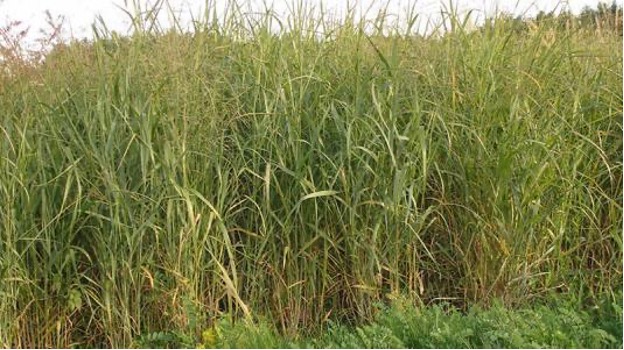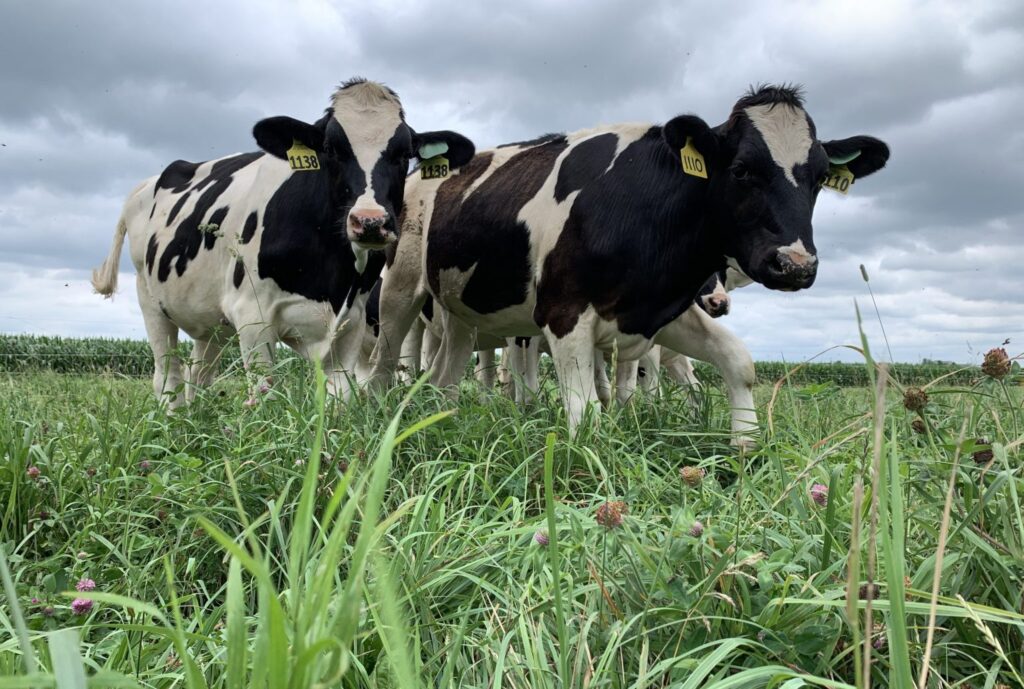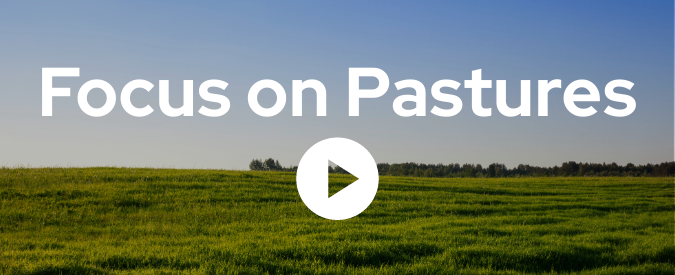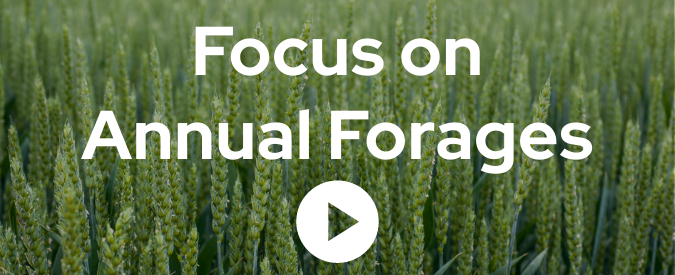Grazing Resource Library
Grazing Resource Library
A well-planned grazing system improves animal flow, decreases labor and leads to improved profitability. Some initial planning goes a long way toward ensuring success.
Fact Sheet
15 Tips for Designing Fencing Systems for Managed Grazing
Following a few best practices when initially laying out the grazing system can yield long-term benefits by streamlining livestock movement and other management activities. Our fact sheet lays out some basic principles of grazing system design.
Fact Sheet
Calculating Carrying Capacity of a Grazing System
How many animals can the land feed? This fact sheet walks the reader through determining pasture productivity, calculating livestock daily requirements to ensure that animal numbers are matched to the land’s carrying capacity.
Pastures for Profit: A Guide to Rotational Grazing (Extension Publication A3529)
Managed grazing is a simple practice that can more than double pasture productivity and reduce reliance of costly stored feeds. This publication walks the reader through the basics of setting up and managing a rotational grazing system (40 pages; 2014).
Lanes That Keep Dairy Animals High and Dry (Extension Publication A3898)
To keep grazing dairy animals healthy, high-quality lanes are needed to keep cattle high and dry. This detailed publication, illustrated with both photos and construction diagrams, offers options for designing and building quality cattle lanes (8 pages; 2010).
Watering Systems for Serious Graziers (USDA-NRCS, Missouri)
For graziers looking to begin, expand, or improve upon current watering systems for grazing herds.
Electric Fencing for Serious Graziers (USDA-NRCS, Missouri)
For graziers looking to begin, expand, or improve upon current electric fencing systems for grazing herds.
A forage base is the collection of feed sources a farmer uses to feed their livestock throughout the growing and non-growing season, including perennial pasture and hay as well as annual forages that are grazed and/or harvested.
A well-planned and managed forage base ensures that adequate pasture and other feed of sufficient quality is available to meet the changing needs of the livestock throughout the year.
Fact Sheet
What Should I Plant In My Pasture?
This fact sheet walks the reader through the process of assessing existing forage resources on a farm and selecting appropriate grasses and legumes to plant to establish new pastures. Information on the characteristics of individual species, seeding rates and species compatibility gives the reader the confidence to make informed decisions when purchasing pasture seed.
Fact Sheet
Renovating Cool-Season Pastures for Improved Grazing
When does a pasture need to be renovated? Good grazing management and attention to soil fertility go a long way toward ensuring pasture health and productivity, but there are times when renovation is the best option. This fact sheet presents a stepwise process for assessing pasture problems and identifying the most effective solution.
Fact Sheet
Managing Rust in Cool Season Pastures
Pasture grasses tend to be fairly disease-free, with one exception, rust. Rust is frequently observed by farmers and does impact pasture yield and quality. It shows up prominently with its dusty orange spore pustules that appear in warm, humid summer conditions.
Soil Fertility Guidelines for Pastures in Wisconsin (Extension Publication A4034)
The soil fertility guidelines contained in this publication help Wisconsin graziers maintain an adequate supply of soil nutrients to support optimal forage quantity and quality and to minimize nutrient losses to the environment. Also includes information on soil sampling and testing and nutrient crediting for legumes and manure (8 pages; 2013).
Identifying Pasture Grasses (A3637)
Color photographs, descriptions, and botanical keys will help you identify young plants and mature stands of more than a dozen common non-native cool-season pasture grasses that you might find on your farm or rural property. Includes management recommendations.
Grasses included: Smooth bromegrass, quackgrass, perennial ryegrass, annual (Italian) ryegrass, orchardgrass, tall fescue, meadow fescue, Kentucky bluegrass, reed canarygrass, Timothy, meadow/creeping foxtail, redtop, barnyard grass, yellow foxtail, green foxtail, and giant foxtail, crabgrass, panicum species (57 pages; 1996).
Identifying Pasture Legumes (A3787)
Legumes are an important component of midwestern pastures. They increase yield and quality of grass pastures and provide nitrogen to grasses. This booklet provides photos, descriptions and botanical keys to help the reader identify the nine most common legumes in midwestern pastures. Includes management recommendations.
Legumes included: crown vetch, hairy vetch, alfalfa, birdsfoot trefoil, kura clover, red clover, sweet clover, alsike clover, and white clover (48 pages; Reviewed in 2017).
Guide to Pasture Condition Scoring (USDA NRCS)
Pasture condition scoring assesses how well a pasture is being managed and how well a pasture is protecting resources. Assess pastures multiple times a year to gauge pasture condition over time and manage accordingly.
Fact Sheet
Stockpile Grazing: A Strategy for Extending the Growing Season
Benefits of extending the grazing season include significant cost savings on stored feed and labor but stockpiling pasture requires some advance planning.
Establishing and Managing Warm-Season Pastures
Native warm-season grass pastures can compliment cool-season grass pastures by providing vital nutrients to grazing herds during the summer slump.
Extending Grazing and Reducing Stored Feed Needs (Extension Publication A3902)
Extending the grazing season and reducing the need for stored feed is highly desirable. Though the best techniques to accomplish this vary with geographic region, type of farming operation, and other factors, this publication outlines strategies that can be used in some or many areas to extend grazing and reduce stored feed needs, thus increasing profit (18 pages; 2009).
Toxic Plants in Midwest Pastures and Forages (Extension Publication A4019)
Prevention is the best way to avoid toxicity problems in forages. While most plants are safe for livestock to consume, a few species can sicken or even kill animals if ingested. This spiral-bound guide identifies common poisonous plants in the Midwest for optimum pasture management (40 pages; 2017).
Dirty Dozen & Beyond: Identifying and Managing 25 Pasture Weeds of Wisconsin
Available in PDF format by connecting with our team.

Well-managed perennial pastures are central to livestock grazing systems. Proper in-season pasture management is the key to optimizing production and quality, ensuring resilience to poor weather, and improving profitability.
Fact Sheet
Managing Pastures in Drought Conditions
While dry and hot conditions in July and August frequently result in a “summer slump” in cool-season pasture growth, longer periods of deficient rainfall can dramatically reduce production and even do permanent damage to pastures. This fact sheet guides the reader through options for keeping pastures healthy and growing during drought conditions.
Fact Sheet
Using a Grazing Stick to Create a Pasture Inventory
Managing pasture forage inventory is key to ensuring livestock have adequate supplies of high-quality forage. A grazing stick is a simple, low-cost tool for monitoring how much forage is available at various points of the season, as well as projecting forage availability throughout the season to ensure the farm is on track to meet its production goals.
Fact Sheet
Stockpile Grazing: A Strategy for Extending the Grazing Season
Benefits of extending the grazing season include significant cost savings on stored feed and labor but stockpiling pasture requires some advance planning.
Extending Grazing and Reducing Stored Feed Needs (Extension Publication A3902)
Extending the grazing season and reducing the need for stored feed is highly desirable. Though the best techniques to accomplish this vary with geographic region, type of farming operation, and other factors, this publication outlines strategies that can be used in some or many areas to extend grazing and reduce stored feed needs, thus increasing profit (18 pages; 2009).
Pastures for Profit: A Guide to Rotational Grazing (Extension publication A3529)
Managed grazing is a simple practice that can more than double pasture productivity and reduce reliance of costly stored feeds. This publication walks the reader through the basics of setting up and managing a rotational grazing system (40 pages; 2014).
Establishing and Managing Warm-Season Pastures
Native warm-season grass pastures can compliment cool-season grass pastures by providing vital nutrients to grazing herds during the summer slump.
Grazing Cover Crops and Annual Forage Resources
How livestock are managed during winter has a profound impact on profitability, labor, animal health, and the environment. Designing a resilient, easy to manage non-growing season strategy that protects resources requires some planning but is well worth the time.
Fact Sheet
Bale Grazing: A Winter Feeding Strategy
Graziers employ a variety of winter feeding strategies. For those who choose to keep their livestock outdoors year-round, bale grazing is a common approach.
Fact Sheet
Stockpile Grazing: A Strategy for Extending the Grazing Season
Benefits of extending the grazing season include significant cost savings on stored feed and labor but stockpiling pasture requires some advance planning.
Extending Grazing and Reducing Stored Feed Needs (Extension Publication A3902)
Extending the grazing season and reducing the need for stored feed is highly desirable. Though the best techniques to accomplish this vary with geographic region, type of farming operation, and other factors, this publication outlines strategies that can be used in some or many areas to extend grazing and reduce stored feed needs, thus increasing profit (18 pages; 2009).
Watering Systems for Serious Graziers (USDA-NRCS, Missouri)
For graziers looking to begin, expand, or improve upon current watering systems for grazing herds.

Managing livestock in a grazing system brings with it different challenges and opportunities compared to confinement. Understanding animal behavior and needs in this system can generate cost savings and improve animal health.
Raising Dairy Replacement Heifers Using Managed Grazing
Raising dairy replacement heifers in a managed grazing system can be a lower-cost solution to dairy farm reproduction needs.
Status of Organic Dairy Pasture Forage Composition, Productivity, Soil Fertility and Grazing Management Practices in Wisconsin
Wisconsin has the largest number of organic dairies in the United States with over 450 dairy farms that represent more than 25% of the nation certified organic dairy farms (USDA NASS, 2014). While pasture forage composition, soil fertility, and management vary across Wisconsin organic dairy farms, many relatively inexpensive improvements can be made immediately on many farms that will lead to improved milk production from pastures (8 pages; 2017).

Managing the bottom line has as much impact on farm viability as managing the pasture and livestock. These tools can help farmers develop sound financial plans and monitor their farm’s performance.
Learn more with Extension’s farm management program.
University of Wisconsin Financial Compass Tools
Wisconsin Hay Market Reports
UW-Madison Extension provides bi-weekly reports from information compiled from public and private quality tested sales and reports in the Midwest.
Wisconsin Dairy Enterprise Budgets
This enterprise budget is a means to analyze the profitability of a particular enterprise. This enterprise budget is intended to analyze a dairy budget, per cow over three levels of production. It includes a machinery and building cost calculator, feed cost calculator and sensitivity analysis.
Wisconsin Beef Enterprise Budgets and Decision Tools
These tools assist beef, small ruminant, and swine producers in making the best financial choices for your operations.
Stocker Enterprise Budgets for Grass-Based Systems (Extension Publication A3718)
Cattle-grazing enterprises have become increasingly popular in the upper Midwest, a region characterized by a favorable grazing season climate and high quality pasture forage production. In the past, most farmers have used a continuous grazing system. This publication examines management-intensive rotational grazing (MIRG) as a strategy of increasing the profitability of grazing in general and stocker production in particular (8 pages; 2001).
Options for Pasturing Animals (Extension Publication A3638)
Livestock owners who want to pasture their animals on someone else land have several options, including leasing pasture or establishing a contract for sale of standing forage. This publication discusses the differences between these two options and explains what to consider if you are planning either type of agreement (20 pages; 1996).
A Consumer’s Guide to Grass-Fed Beef (Extension Publication 3862)
Learn about the health and environmental benefits of grass-fed beef and how to buy and cook grass-fed beef. Includes several recipes (12 pages; 2022).
Adoption of managed grazing can yield significant environmental benefits in addition to financial rewards. Well-managed grazing, planned with water quality, soil health, or wildlife in mind can reap additional benefits.
Grazing to Protect Surface Water: Considering critical and sensitive areas
Learn to define and identify critical and sensitive areas on Wisconsin farms and how to manage those areas when they are most prone to damage, sediment loss, and nutrient transport.
Setting the Gold Standard for Ecosystem Services
Learn why well-managed pasture grazing systems are win-win-win situations for farmers, their communities, and the environment.
Establishing and Managing Warm-Season Pastures
Native warm-season grass pastures can compliment cool-season grass pastures by providing vital nutrients to grazing herds during the summer slump.
Understanding Soil Carbon Dynamics in Pasture Systems
What do we know about carbon storage in grasslands, and how can we manage our pastures to encourage carbon sequestration?
Grazing Streamside Pastures (Extension Publication A3699)
Wisconsin’s streams are one of our most precious natural resources. When streams flow through pasture lands, good grazing management practices are needed to prevent erosion and preserve water quality. This publication describes how to protect stream health and ensure pasture productivity (16 pages; 1999).
Managing Pastures for Water Quality: Understanding Riparian Areas (Extension Publication GWQ057)
The narrow green areas along banks of rivers, lakes, and ponds contain unique plant communities, soils, and wildlife habitats. This publication describes the nature and ecological function of these areas, discuss the state laws that apply to them, and note ways in which these areas may be protected, including by instituting proper grazing procedures, minimizing construction and development disruption, and maintaining a permanent buffer of vegetation between the water and nearby farmland (16 pages; 2011).
Managing Pastures for Water Quality: Strategies for Seasonal Livestock Use (Extension Publication GWQ058)
The narrow green zones along banks of rivers, lakes, and ponds may offer good grazing but are easily damaged. This publication outlines tactics for grazing such areas in ways that minimize the likelihood of damaging vegetation, destroying wildlife habitat, polluting water, or increasing soil erosion. Among the numerous strategies described: deferring rotation, planning short grazing periods, and locating winter feeding areas away from the water (12 pages; 2011).
Grassland Birds: Fostering Habitats Using Rotational Grazing (Extension Publication A3715)
Over 40 species of grassland birds breed in Wisconsin, and some open grassy areas, such as prairies, hay fields, small grain fields or pastures are required during the breeding season. Farmers can help stem the decline of grassland birds by increasing or implementing rotational grazing plans (14 pages; 2001).
Podcasts
Videos
Farmer-driven research is key to improving the performance of grazing and livestock systems in Wisconsin. This page provides thumbnails of current grazing research highlighting on-farm research in partnership with graziers.

2024 Wisconsin Bale Grazing Project Research Brief
In response to farmer interest in winter bale grazing, we designed a research project that sought to answer some of their questions about the practice. This brief summarizes data from the first year of a two-year study.








